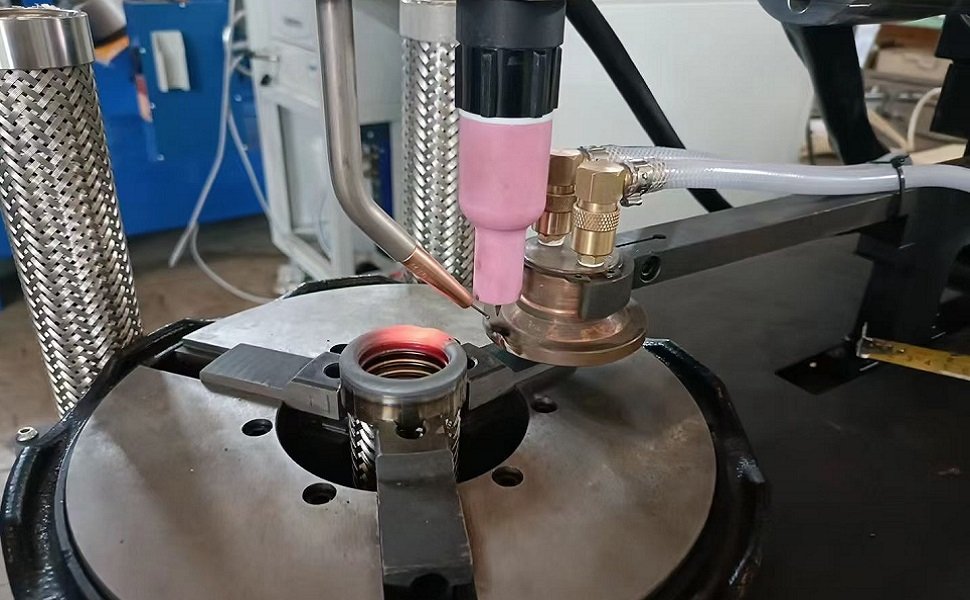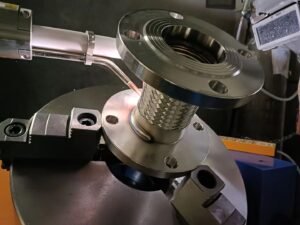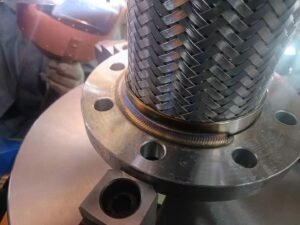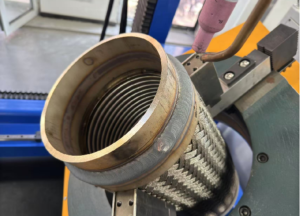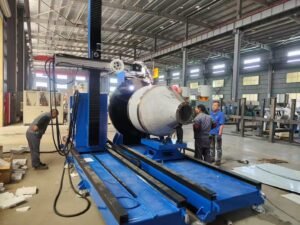In the production of metal hoses and bellows, welding processes are at the core of ensuring high-quality products with precision and durability. While traditional welding methods have been the industry standard, the increasing demand for efficiency, quality, and automation is pushing the sector toward innovative solutions. In this article, we’ll explore the advantages and disadvantages of traditional welding techniques, and how the introduction of automatic welding machines (particularly the TIG process) is revolutionizing metal hose and bellows production, including specialized applications like steel braided hoses and flexible metal hoses.
Traditional Welding Processes: Manual and Semi-Automatic Welding
Traditionally, the production of steel hoses, metal hoses, and bellows has relied on manual or semi-automatic welding methods, such as MIG/MAG welding and TIG welding. While these methods have been effective, they come with certain limitations that can affect production efficiency and product quality.
Advantages:
- Flexibility: Traditional welding methods offer flexibility, especially when dealing with complex angles and intricate details in steel braided hoses and flexible metal hoses. Operators can adjust welding parameters based on real-time conditions, allowing for customization.
- Lower Equipment Costs: Compared to fully automated systems, traditional welding setups generally require a smaller initial investment in equipment, making them more cost-effective for smaller operations producing metal hoses or bellows.
Disadvantages:
- Low Efficiency: Manual welding is labor-intensive and time-consuming, often leading to decreased production speed. Additionally, human errors during welding can reduce efficiency and increase scrap rates, especially in high-precision applications like steel hoses.
- Inconsistent Quality: Welding quality is highly dependent on the skill level of the operator, leading to fluctuations in the consistency of the welds. This can result in defects, such as weak joints or uneven beads, which are particularly problematic in the production of flexible metal hoses.
- High Labor Intensity: The repetitive nature of manual welding leads to worker fatigue, which not only impacts efficiency but can also increase the risk of safety incidents in the workplace.
- Environmental Pollution: Traditional welding processes produce significant amounts of smoke, fumes, and particulate matter, contributing to air pollution and requiring additional ventilation and safety measures.
The Advantages of Automatic Welding Machines (TIG Process) in Metal Hose and Bellows Applications
As the industry embraces automation, TIG welding (Tungsten Inert Gas welding) has emerged as the preferred method for metal hose and bellows production due to its superior precision and weld quality. The transition to automatic welding systems offers several key advantages, particularly in applications such as steel braided hoses and flexible metal hoses.
Advantages of Automated TIG Welding:
- High Precision and Quality: TIG welding ensures exceptional joint quality with minimal defects, making it ideal for metal hose and bellows applications, where high precision is crucial. The ability to control heat input and maintain stable arc conditions leads to consistent, high-quality welds, particularly in the production of steel hoses.
- Smooth and Defect-Free Weld Beads: The automatic process allows for fine control over the weld bead, resulting in smooth, uniform welds. This reduces the need for post-weld finishing and improves overall production efficiency, particularly in flexible metal hose production where smooth welds are essential.
- Energy Efficiency: TIG welding maximizes energy utilization by focusing heat precisely on the weld area. Automatic systems further enhance energy efficiency by operating continuously and with minimal downtime, leading to significant cost savings for manufacturers of steel braided hoses.
- Enhanced Stability and Consistency: Automated TIG welding systems minimize the reliance on human intervention, resulting in stable, repeatable processes. This ensures consistent product quality across large production runs of metal hoses, reducing variation and defects.
- Reduced Labor Intensity: Automation significantly reduces the need for manual intervention, alleviating the physical strain on workers and decreasing the risk of workplace injuries. This also helps in optimizing workforce allocation.
- Lower Labor Costs: By reducing the need for manual labor, automated welding systems help lower labor costs. The continuous operation of machines increases productivity while decreasing the workforce required for production.
- Environmental Benefits: Automated welding processes generate fewer emissions and pollutants compared to manual methods. The precise control over heat input and arc stability also reduces the production of harmful fumes, contributing to a cleaner and safer working environment.
The Future of Automatic Welding Machines
As technology continues to evolve, TIG welding machines are expected to become even more advanced, with innovations aimed at further improving the speed, precision, and energy efficiency of the welding process. The integration of AI, machine learning, and real-time data monitoring could allow for even more refined control, leading to breakthroughs in weld quality and automation levels.
With automatic welding systems now offering unparalleled precision, efficiency, and cost savings, we can expect to see more industries adopting automated welding for metal hose, steel braided hose, and bellows production. This shift will not only optimize production workflows but also offer a competitive edge in an increasingly demanding market.
Looking Ahead: The Promise of Automated Welding for Metal Hoses and Bellows
The growing adoption of TIG welding automation in metal hose and bellows manufacturing is a game-changer. As the technology becomes more affordable and accessible, it will continue to shape the future of welding, providing companies with the tools they need to stay ahead in a competitive landscape. With advancements in automation, we can look forward to more efficient, environmentally friendly, and cost-effective manufacturing processes for steel braided hoses, flexible metal hoses, and other steel hoses.
Let’s embrace the future of welding technology—where precision meets automation, and innovation drives industry transformation.
